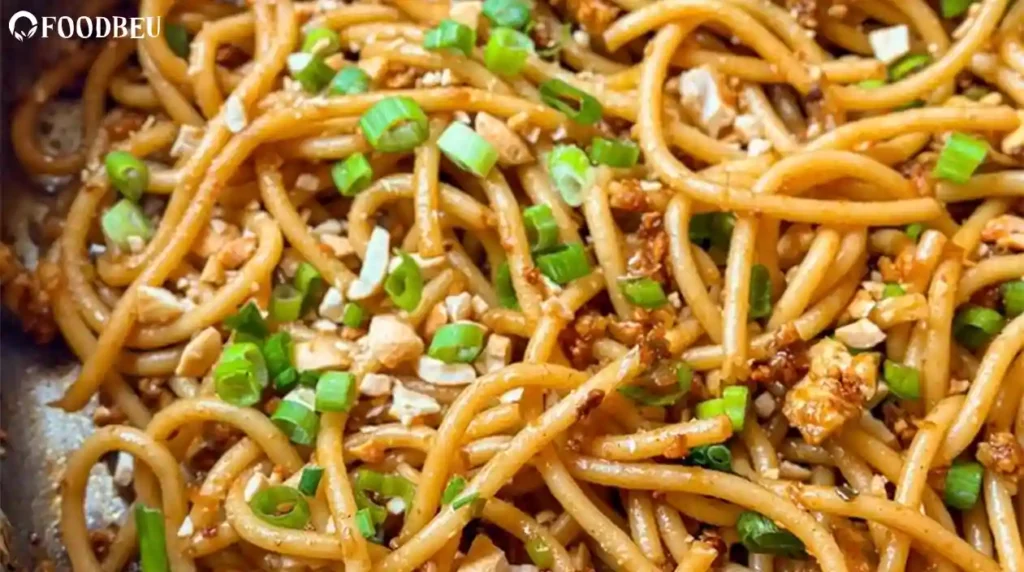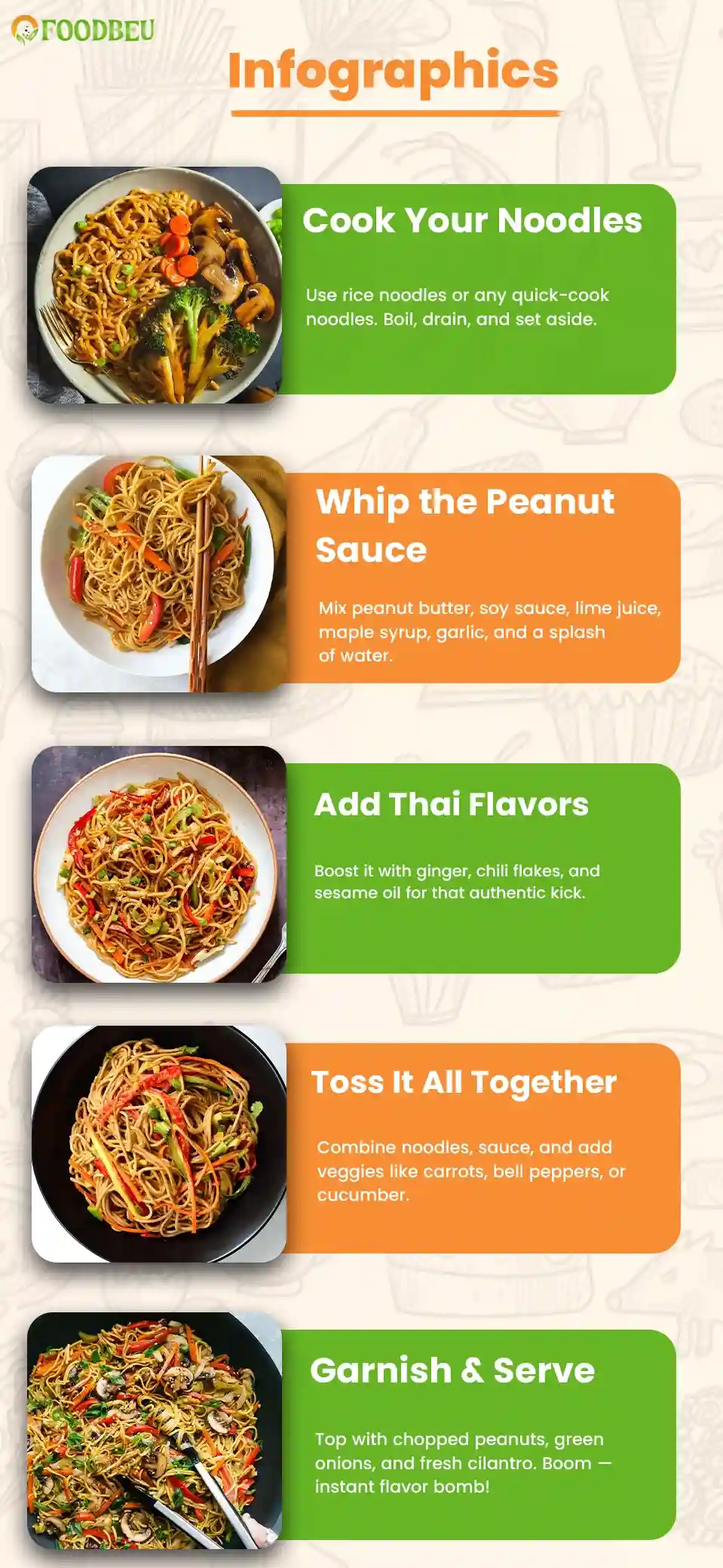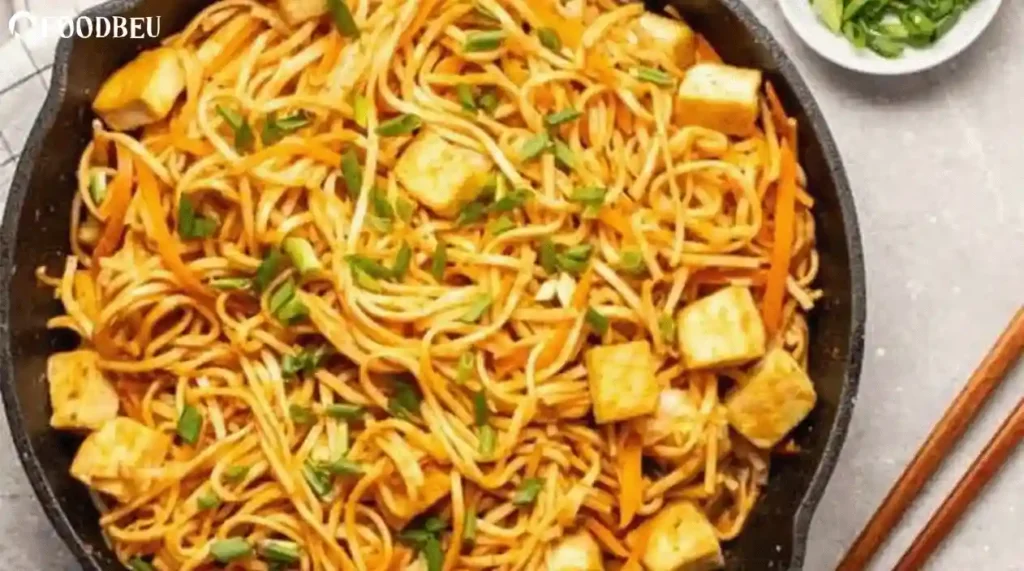Spicy if you want it to be, sweet if that’s your thing, salty as a baseline.
This peanut noodles recipe doesn’t whisper Thai influence, it screams it, unapologetically, through that bold, unmistakable Thai peanut sauce recipe-style coating that clings to every single noodle like it was meant to be there from the start. There’s no meat, no dairy, nothing you can’t pronounce, just plant-based, pantry-friendly stuff doing big things.
It’s fast, too. Start to finish in under 20 minutes unless you’re slicing veggies like it’s your first day with a knife; Oh, and it also makes leftovers you’ll want to eat cold out of the fridge.
Why This Peanut Noodles Recipe Works (And Wins)
- Quick. It’s weeknight food. No long waits. No slow roasting.
- Flexible. Swap out noodles. Change veggies. Adjust heat. It’s got range.
- Flavor-blasted. The peanut butter sauce? Layers. Salty, sweet, tangy, spicy. All of it.
- Plant-based. 100% vegan. No substitutions needed.
- Meal prep ready. This is the kind of dish that gets even better the next day.

Visit: Hash Brown Patties – Crispy, Golden & Easy to Make at Home
Ingredients: Nothing Fancy, All Flavor
Here’s what you need to throw this thing together. You probably have most of it already. If you don’t, you’ll want to keep these around going forward.
Noodles
- 8 oz rice noodles (or soba, spaghetti, linguine, just cook them al dente)
For the Thai Peanut Sauce Recipe
- 1/3 cup creamy peanut butter (or almond butter, if you’re chasing a peanut butter alternative)
- 2 tbsp soy sauce (or tamari for gluten-free)
- 1 tbsp maple syrup or agave
- 1 tbsp rice vinegar
- 1 tbsp toasted sesame oil
- 1 tsp sriracha or chili garlic paste (adjust to taste)
- 1/2 tsp grated ginger (fresh is best, but powdered in a pinch)
- 2 tbsp warm water (more if needed to thin out)
Toppings & Veggies
- 1 cup shredded red cabbage
- 1 cup julienned carrots
- 1 red bell pepper, thinly sliced
- 2 green onions, sliced
- 1/4 cup chopped fresh cilantro
- 1/4 cup crushed roasted peanuts (for crunch)
- Lime wedges (for squeezing)

Discover: Banana Bread Recipe – Soft, Moist & Easy to Bake Every Time
Step-by-Step Instructions: How to Make Peanut Sauce & Assemble It All
Step 1: Boil the Noodles
Read the complete instructions on the noodles package and cook your noodles accordingly. Make sure not to overdo it. Drain them. Rinse under cold water so they don’t stick and clump into a tragic noodle blob.
Step 2: Make the Thai Peanut Sauce
Toss peanut butter, soy sauce, maple syrup, rice vinegar, ginger, sriracha, and sesame oil into a bowl.Add warm water – just a little – stir until it turns creamy, smooth, pourable.Too thick? More water. Too thin? You went too far.Cold water ruins it; warm water makes it magic.
Need to know how to make peanut sauce just right? The trick is warm water. Cold water clumps it. Warm loosens everything like magic.
Step 3: Mix It Up
In another large bowl, put your cooked noodles with the peanut sauce until they’re coated. Every strand should be glossy and rich-looking. You want them drenched.
Explore: How to Cook Tofu – Crispy Air Fryer & Pan-Fried Vegan Recipes
Step 4: Add the Crunch, the Fresh, the Finish
Toss in your fresh veggies. Add cilantro. Sprinkle with chopped peanuts. Squeeze a lime wedge over the top for that zing that hits different.
Done.
Make It Yours: Customization Ideas
This isn’t a rigid dish. It’s adaptable. Change it up depending on what’s in your fridge or what mood you’re in.
Add Protein
- Tofu (pan-fried, air-fried, baked – whatever)
- Tempeh (marinated in soy + maple = incredible)
- Chickpeas (roasted or just tossed in)
Swap the Noodles
- Rice noodles for lightness
- Whole wheat spaghetti if that’s your thing
- Ramen noodles for texture
- Zoodles (zucchini noodles) if you’re skipping carbs
Heat It Up
More sriracha. Chili flakes. A touch of gochujang if you’re bold.
Go Nut-Free
Use sunflower seed butter or tahini instead. Tastes different, still fantastic. Perfect peanut butter alternative for allergies or just curiosity.
Learn More: How to Bake Chicken Wings Crispy in 25-30 Minutes
Leftovers? Cold or Hot, Still Fire
Cold the next day? Incredible. Something about the way the noodles soak in all that sauce makes the flavors hit deeper after a chill night in the fridge.
Want it warm? Toss leftovers in a skillet with a splash of water or soy sauce. Instant reheated joy.
How to Store It Like a Pro
- Store in airtight containers.
- Keeps in the fridge for 3–4 days.
- You can freeze the peanut sauce solo, but not the full dish (noodles get weird).

Why Thai Peanut Noodles Just Work
There’s a reason Thai food recipes have gone global. The flavor balance – the harmony between sweet, salty, sour, and spicy – is unmatched. This dish leans hard on that blueprint.
The base of the peanut butter provides a comfortable feel. Soy sauce, vinegar, and lime bring a tangy and salty taste. And sriracha adds a kick that you feel in your chest, not your tongue.
Now add crisp vegetables to break the creaminess. A squeeze of lime cuts through the fat. And it’s done.
It’s the kind of flavor layering that studies show can boost satiety and make meals more satisfying (Miller, 2014). You feel full, but not heavy. Satisfied, not sluggish.
Check this out: Easy Vegetarian Tofu Recipes for Healthy and Delicious Meals
Serving Ideas: Make It a Meal
- Serve with a cucumber salad dressed in rice vinegar + sesame oil.
- Add a Thai iced tea or coconut water to cool off from the heat.
- Toss in chopped mango for a sweet twist.
This is the peanut butter noodles recipe that behaves like it has ten times the ingredients. It’s bold enough to stand alone, chill enough to be a side.
Nutritional Notes (But Keep It Chill)
You’re working with plant-based fats, which are generally beneficial in moderation. Peanut butter brings protein. Vegetables bring fiber and crunch. Noodles bring the carbs that fuel you.
Want to make it lighter? Halve the noodles and double the veggies. Use powdered peanut butter. Swap maple syrup for monk fruit sweetener. Done. Still great.
One of the studies show that balanced vegan meals with whole grains and plant proteins can reduce inflammation and improve gut health (Tuso et al., 2013). So this dish isn’t just a pretty face, it does the work.
| Nutrient | Amount |
| Serving Size | 1 serving |
| Calories | 615 kcal |
| Total Fat | 34 g |
| Saturated Fat | 6 g |
| Carbohydrates | 62 g |
| Dietary Fiber | 6 g |
| Sugars | 13 g |
| Protein | 20 g |
| Sodium | 784 mg |
How do I stop the noodles from clumping once they cool down?
Rinse ‘em cold, toss with a slick of sesame oil, and store them covered like they’re royalty – because left exposed, they stiffen into clumps fast, and no amount of stirring will undo that sadness; but if you keep them sealed, give them a mix once mid-chill, they stay loose and coated like you just made them.
Final Word: Easy, Fast, Flavor-Loud
This isn’t one of those dishes where you feel like you cheated because it was too easy. This peanut noodles recipe delivers real-deal Thai flavor, quickly, with no fuss and no animal products. That’s the win.
Cook it once, memorize the thai peanut sauce recipe, and you’ll come back to this over and over again.
Call them peanut noodles, peanut butter noodles, thai peanut noodles – whatever. They are the best!



